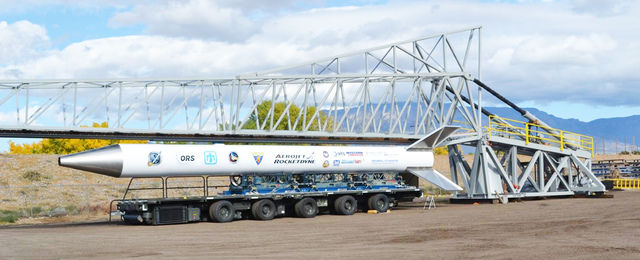MANA — Hawaii’s first space launch — aimed at testing a low-cost launch system for small satellites — will blast off from Kauai’s military base on Oct. 29. The ORS-4 mission, sponsored by the Operationally Responsive Space (ORS) Office in
MANA — Hawaii’s first space launch — aimed at testing a low-cost launch system for small satellites — will blast off from Kauai’s military base on Oct. 29.
The ORS-4 mission, sponsored by the Operationally Responsive Space (ORS) Office in collaboration with the University of Hawaii and the Pacific Missile Range Facility, sets to test the rail-launched rocket Super Strypi, which will deploy a UH student-made satellite.
“Ideally, this launch will be a gateway to a future of space-type applications, developed from the colleges and perhaps even branching off commercial-type development companies from this,” said Marcus Yamaguchi, lead student at the Kauai Community College ground tracking station at the Daniel K. Inouye Technology Center.
“The overall goal is to try and develop something that can help bring high-tech business to the islands to help establish something for us here that’s specific and kind of a niche to our islands because of our access to the missile facility at PMRF,” he added.
Yamaguchi said KCC’s tasks are to provide ground station support and control after the rocket deploys the satellite.
“The initial responsibility will to establish communication link with the (satellite) from our ground station,” he said. “Mainly for us it’s a matter of providing that control for UH Manoa and also providing additional data collection for them as well.”
Capt. Bruce Hay, PMRF commanding officer, said the rocket being launched is called Super Strypi, a 62,000-pound vehicle that’s able to deploy up to three satellites into orbit.
“The Super Strypi is a concept from the Office of Responsive Space to get things into space quicker with less cost,” Hay said.
Luke Flynn, Hawaii Space Flight Laboratory director, said the cost for the October mission will be tens of millions of dollars cheaper than similar launches.
“Typically, launches right now in a similar class cost between $30 million to $40 million,” he said. “We’re hoping that this launch will be about $15 million a launch.”
If it is successful, Flynn said, future launches will be able to carry and deploy multiple satellites.
“Google currently launches small satellites at this size for around $20 million a launch for a single satellite weighing about 100 kilograms,” he said. “We can put at least two, maybe three satellites on a launch and so you can see how that drives down the cost to $5 million to $7.5 million per satellite, so there’s a lot of interest in this.”
Flynn said the rocket will release a small satellite about 300 miles in space.
The Hyperspectral Imaging, Aeronautical Kinematic Analysis satellite — called HIAKA, which also means “to recite legends or fabulous stories” in Hawaiian — has a camera that will allow researchers to monitor environmental effects on the surface of the planet.
“It’s a satellite that has a hyper-spectral imaging camera on it that’s going to take data in the thermal infrared part of the spectrum,” Flynn said. “You are going to be able to tell things like weather, ocean temperatures; you are going to be able to discriminate things like lava flows on volcanoes and things and that’s what we’re really interested in — the environmental effects of different things going on in the planet.”
For example, the satellite will be able to observe urban heat islands like Los Angeles, Flynn said.
“Different parts of the city heat up in the day, and it creates conditions that are detrimental to health, and we can monitor that we the satellite as well,” he said.
Flynn said about 60 students participated in the creation of the satellite that took three years to develop and build.
“We’ve worked toward diversifying a lot of our small satellite building efforts to the community colleges, (and they) are starting to work on this as well,” he said. “KCC is one of the primary builders of the future that’s going to be working on a lot of the instrumentation of HSFL small satellites.”
Georgeanne Purvinis, Hawaii Space Flight Lab Kauai associate director at KCC, said the launch will provide students with valuable knowledge and experience.
“One of the best things is all of the experience that the students have, and they learn a lot going through an entire NASA project,” she said. “We have to go through the reviews in NASA style. Every step of the way there’s a review. The students, they learn — not only the electronics and science along the way — to produce something according to commercial and NASA standards.”
She said six students are currently working on NASA projects.
Yamaguchi, who will transfer to UH Manoa in the fall, said an additional two students will join incoming lead student Nick Herrmann to help manage and operate the ground station.
“That includes the necessary preparations for the upcoming launch system upgrades, system characterizations as well as operation of the ground station of the up-link, down-link data collection,” he said.
Yamaguchi said students will need to obtain an amateur ham radio station in order operate the ground station.
Hay said PMRF will provide safety, infrastructure and range services for the mission; however, he doesn’t envision the base to be a spaceport.
“We are not a spaceport and don’t envision being one, but we have a large infrastructure to support launching pretty big things,” he said.
Hay said if Hawaii is chosen to be site for future similar launches, it will keep science and technology jobs in Hawaii.
“If you’re kid at UH Manoa, you go to Florida or California right now for this kind of jobs,” he said. “It be nice if you graduate UH Manoa and stay right here at home.”



